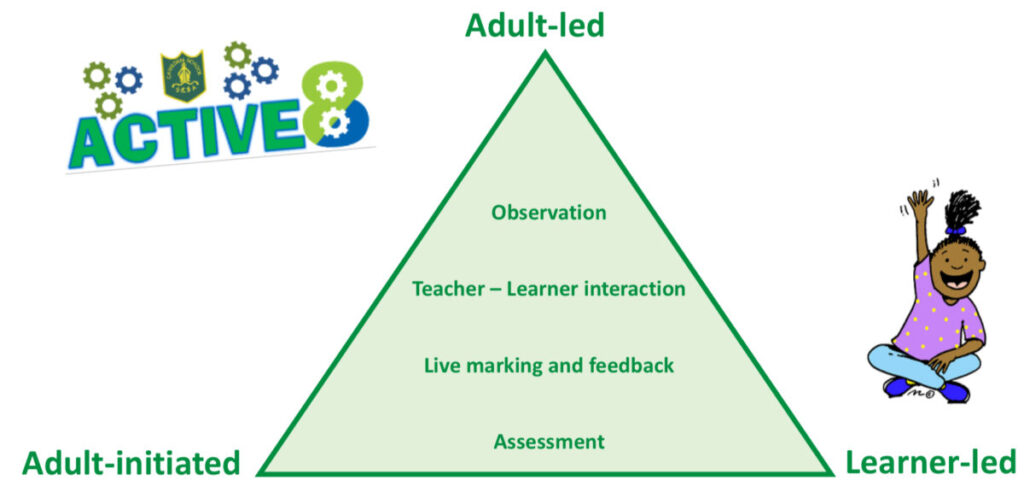 ‘There is no contest between child-led and adult-led learning. It is the one without the other that gives children an impoverished educational experience.’
‘There is no contest between child-led and adult-led learning. It is the one without the other that gives children an impoverished educational experience.’
(Julie Fisher, as cited in ‘Interacting or Interfering’, 2016)
OLGA Cathedral Primary School’s Active8 approach, which was introduced across the school in August 2021, provides a daily structure for the delivery of our curriculum. Active8 seeks to develop confident, independent and responsible learners who benefit from genuine personalisation and choice in their learning whilst still receiving their full entitlement to a Broad General Education across all curriculum areas, delivered in creative and innovative ways. You can read more about the rationale behind Cathedral’s Active8 approach via the link below:
curriculum. Active8 seeks to develop confident, independent and responsible learners who benefit from genuine personalisation and choice in their learning whilst still receiving their full entitlement to a Broad General Education across all curriculum areas, delivered in creative and innovative ways. You can read more about the rationale behind Cathedral’s Active8 approach via the link below:
Active 8 and overarching pedagogy rationale
A typical Active8 day includes a variety of teacher-led, independent and collaborative activities. Whole-class lessons still feature, where appropriate, along with ‘fixtures’ such as assembly or Physical Education. Each day’s learning is set out on the Active8 task-board and various icons indicate if, for example, the activity requires direct input from the teacher, should be completed using a digital device, or is a ‘Milestone Moment’ (i.e. an assessment activity).
Whole-class lessons still feature, where appropriate, along with ‘fixtures’ such as assembly or Physical Education. Each day’s learning is set out on the Active8 task-board and various icons indicate if, for example, the activity requires direct input from the teacher, should be completed using a digital device, or is a ‘Milestone Moment’ (i.e. an assessment activity).
As outlined below, there is an appropriate balance of adult-led, adult-initiated and learner-led learning across each week. There is daily differentiated direct teaching to literacy and numeracy groups, as well as regular whole-class lessons. Often, a lesson (e.g. art or science) will be taught and then the follow-up activity will remain on the task-board for an entire week so that learners can complete it at a time of their choosing. There are also opportunities for learners to access the ‘continuous provision’ in the various areas of their learning street (e.g. Technology, Art Attack, Publication Station) and engage in truly learner-led learning, when they can access and use the available resources to take learning in a direction of their choice.
A major advantage of Cathedral’s Active8 approach is that it creates time and space for the teacher to observe learners, provide one-to-one support, give live feedback and engage in high-quality learning dialogues.
The overarching pedagogy (the way in which we plan, teach, organise, facilitate and support learning) across Cathedral Primary School draws on the work of an Early Years specialist called Julie Fisher and exploits three main ways in which children learn. This is illustrated in the diagram below.
ADULT-LED LEARNING: teachers focus and direct children’s thinking
The teacher has planned outcomes and stays with pupils whilst learning takes place (e.g. a reading or maths group; a whole-class writing lesson).
ADULT-INITIATED LEARNING: teachers ignite children’s thinking
The teacher sets up a starting point with planned intentions and then stands back to wait, watch and wonder. Pupils engage independently until their teacher joins to observe, interact or enhance learning.
LEARNER-LED LEARNING: teachers follow children’s thinking
Resources, experiences and outcomes are freely chosen by the learner(s) and are under their control. This may or may not involve direct interaction with their teacher.
Cathedral’s Active8 approach to learning, teaching and assessment allows the above to happen very naturally across all classrooms on a daily basis.
To summarise, the key features of Cathedral’s Active8 approach are:
- Flexible timetabling, set out on the Active8 task-board, rather than fixed subject blocks;
- Learners leading and taking responsibility for their own learning;
- Learners being able to choose from a range of activities, with the freedom to decide the order in which they complete them, and being personally responsible for managing their own time;
- Learners having free access to learning spaces and resources;
- An emphasis on creativity and exploration, with activities often including collaborative, hands-on learning and open-ended enquiry-based projects;
- Teachers who are not only skilled instructors, leading and directing activities, but who also act as facilitators, guiding learners and knowing when to step back, watch and wait.

